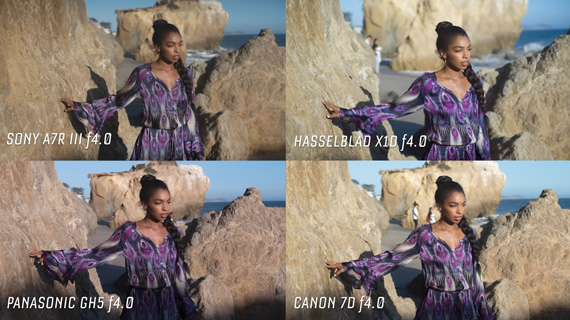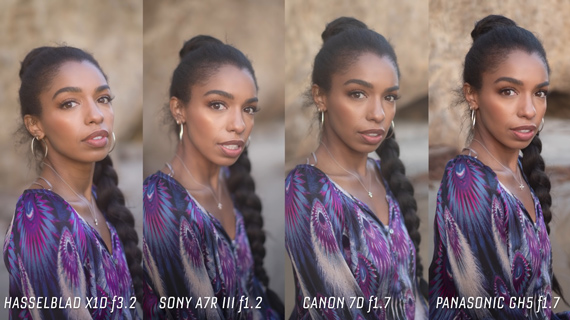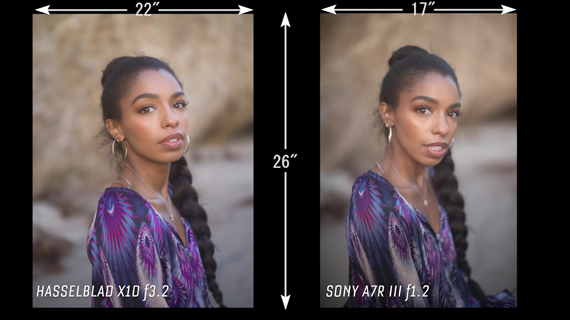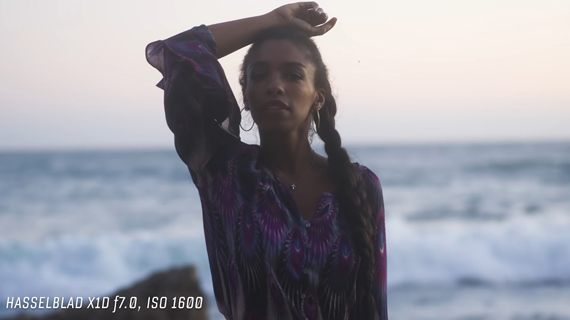In digital photography, the image sensor plays the important role of capturing light. Once the photodiodes in the sensor are exposed to light, light is converted into a digital signal and an image is formed. Like film, camera sensors come in a variety of sizes. Variation in sensor size affects depth of field, the ability to capture details, and grain structure. Jay P. Morgan and Kenneth Meryl from The Slanted Lens explain:
For comparison, the demo used the following cameras (in order of largest to smallest sensor):
- Hasselblad X1D with a Medium Format Sensor
- Sony A7RIII with a Full Frame Sensor
- Canon 7D with an APS-C Sensor
- Panasonic GH5 with a Micro 4/3 Sensor
Sensor Size and Depth of Field
All variables remaining the same, the medium format sensor produces the shallowest depth, and the micro 4/3 produces the greatest. This is to say that if you take an image with the same f-stop value in all the cameras, the medium format camera will melt the background into a creamy bokeh quite aggresively compared to other cameras with smaller sensors.
For instance, notice that at f/4.0 the image from the Hasselblad has more background blur than the other images (shallow depth). The image from the micro 4/3 sensor has the least blur (greatest depth).

The image from the Hassleblad has the softest background and the one from the Panasonic is the sharpest at the same aperture.
From this example, we see that a medium format sensor can struggle to give you greater depth in your image. On the other hand, a micro 4/3 sensor can again struggle with shallow depth of field. But with the variety of lenses that are available, it seems that a full frame sensor is the one that can provide the best of both worlds; full frame cameras are more flexible.

With a lens having an aperture of f/1.2, a full frame camera can beat a medium format camera for shallow depth of field.
Sensor Size and Image Details
Besides sensor size, the details captured by a sensor also depend on the sensor resolution. In this case, the 50MP Hassleblad is able to capture more details in its image that can be blown up to a greater size than the image from the 42MP A7RIII sensor. However, a 24MP full frame sensor like that of the A7II will still have lesser details in its image than that of the A7RIII.
Sensor Size and Noise
A bigger sensor means that the photodiodes that capture light are bigger too. This results in the the bigger sensors performing well in low light conditions. While smaller sensors introduce more noise at higher ISOs in low light conditions, bigger sensors produce much cleaner and detailed images under the same circumstances.
Does Sensor Size Matter?
Now that you know what parameters are affected by sensor size, do you feel that sensor size matters? Meryl finds the full frame camera to be in the sweet spot. A full frame camera can produce results comparable to those of a medium format and also has the flexibility over depth of field. Moreover, it is budget friendly compared to a medium format.
Do you feel that your camera’s sensor size is adequate for your needs? Or do you feel a need to upgrade? Let us know in the comments.
Like This Article?
Don't Miss The Next One!
Join over 100,000 photographers of all experience levels who receive our free photography tips and articles to stay current:








Leave a Reply